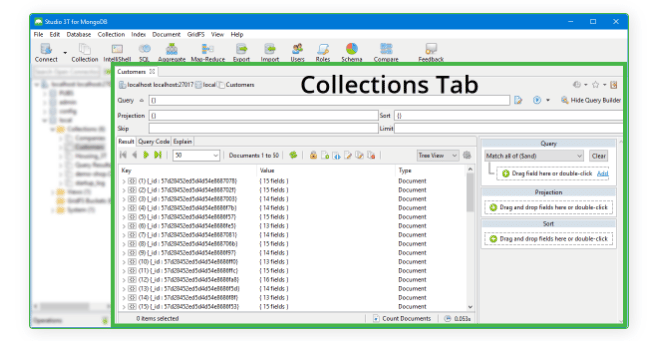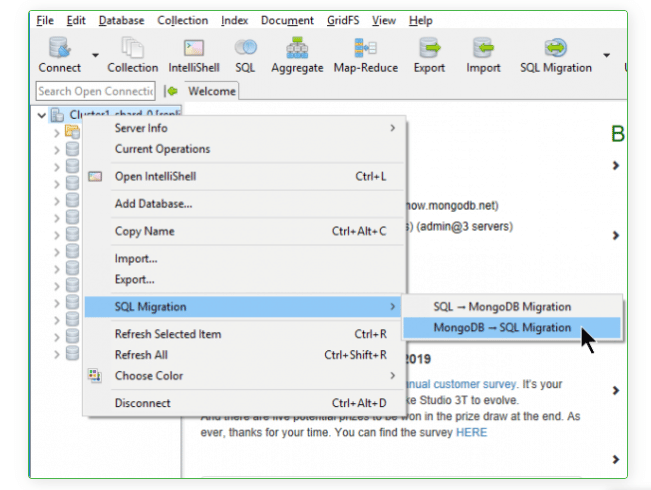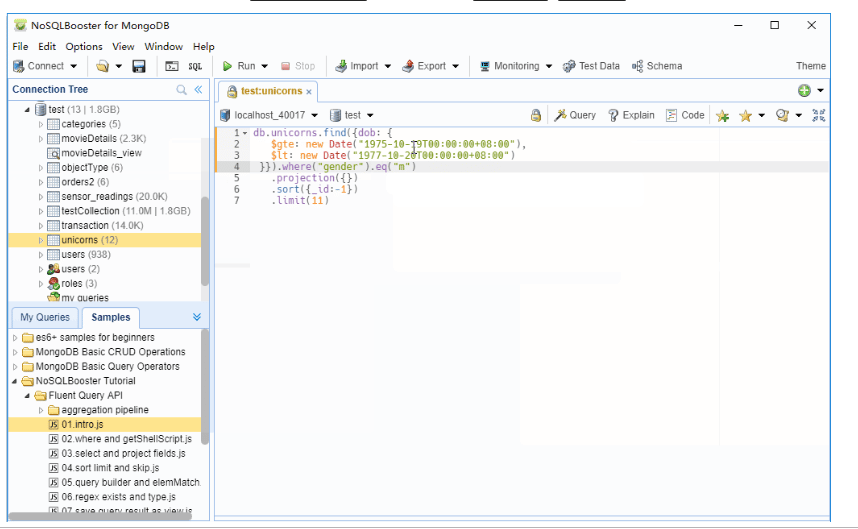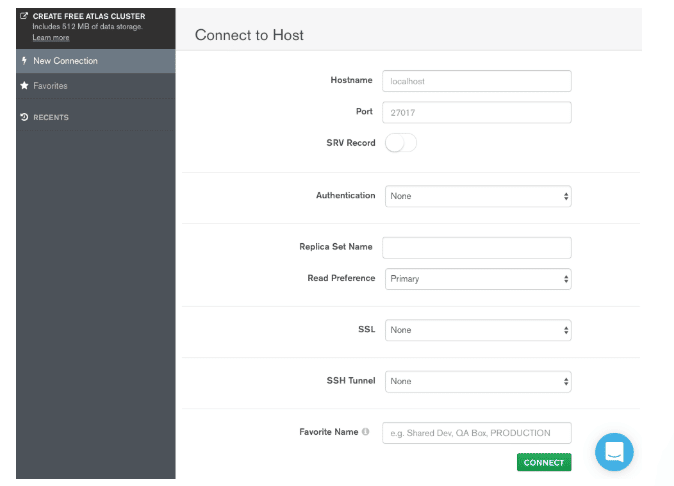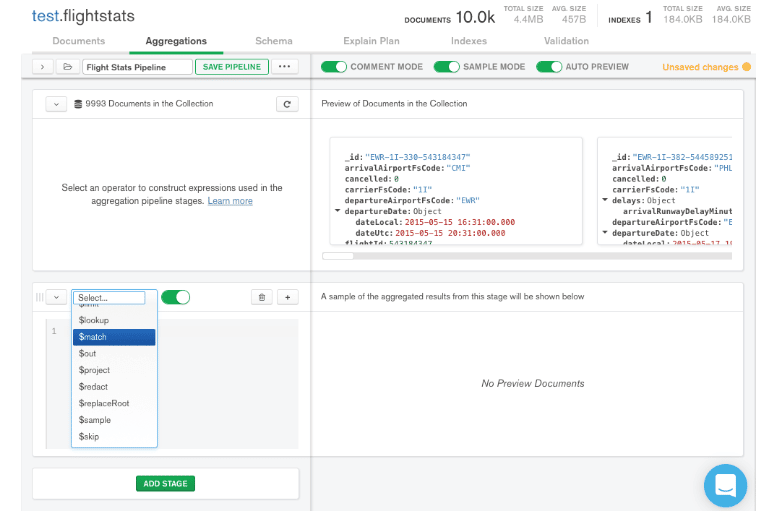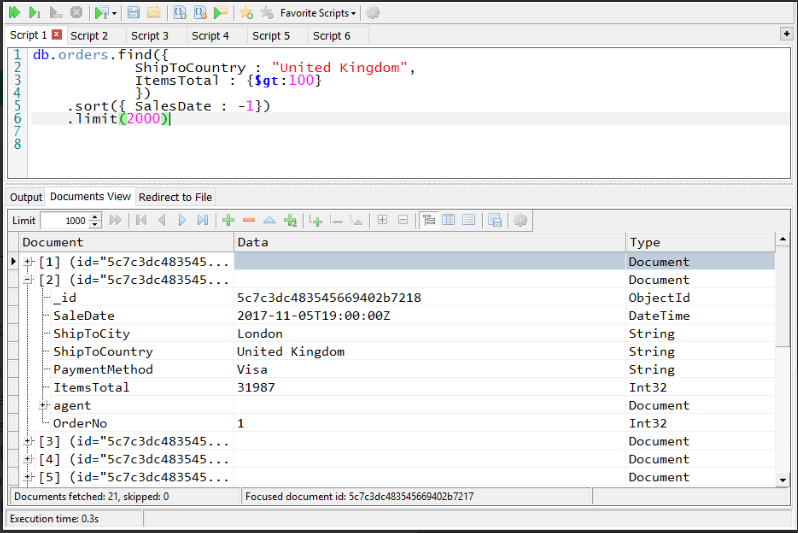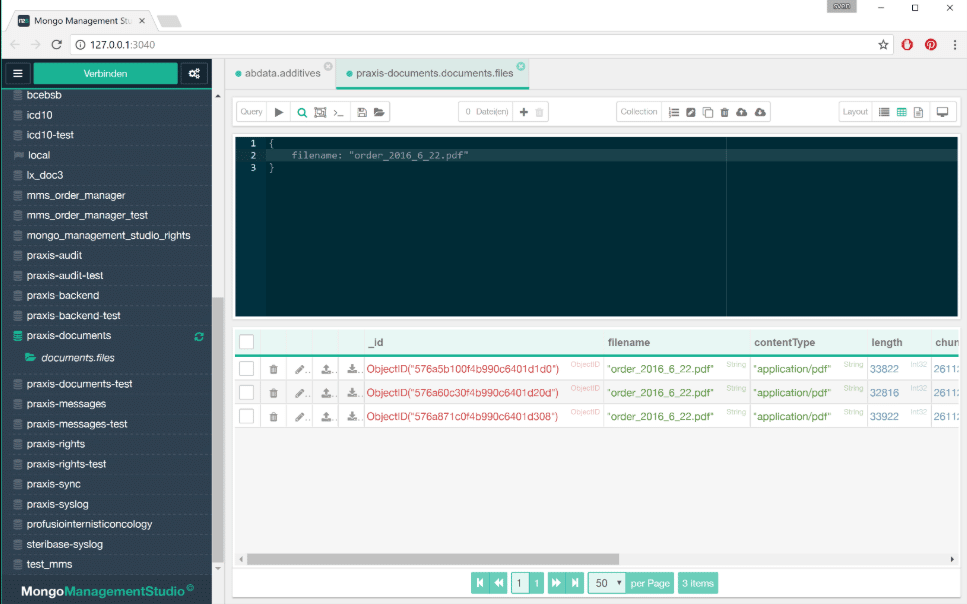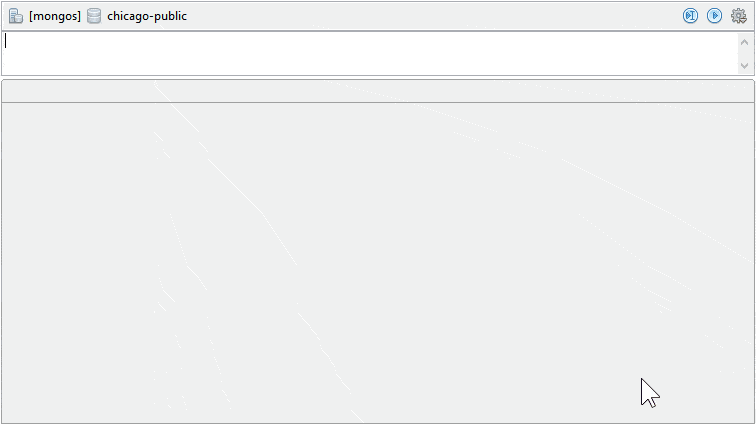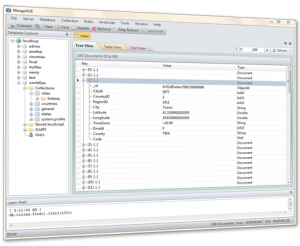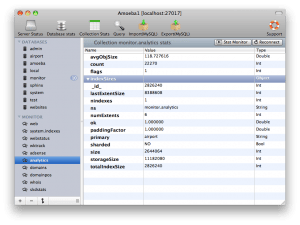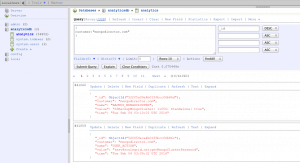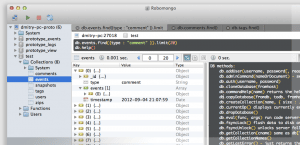A good UI is an important part of the development experience. The MongoDB Shell works great for administrative actions, but when working with larger amounts of data, the UI becomes fairly important.
In 2014, we discussed 4 of the top MongoDB GUIs: MongoVue, MongoHub, RockMongo, and Robo 3T (formerly Robomongo), and again in 2016: MongoDB Compass, Robo 3T, Studio 3T, and MongoBooster. We left those at the end of this post for your review. Since then, however, many new options have emerged to help you optimize your MongoDB management and we thought we’d share our updates.
Comparing MongoDB GUIs
In this article, we are going to compare 6 of the top MongoDB Graphical User Interfaces that help developers increase their productivity and manage their database. We’ll be focusing on data visualization, presentation, and editing. As always, your mileage will vary depending on your scenario and preferences. Read on to find out which is the best MongoDB GUI for you, updated for 2019, that contain these key features:
- A good visual editor to write and edit queries faster.
- Autocompletion of queries.
- An aggregation framework to write aggregation queries faster without errors.
- Should facilitate data transfer between RDBMS and MongoDB.
- Should have an excellent way to measure server and query performance.
1. Studio 3T
Studio 3T is probably the most advanced GUI tool out there for MongoDB. They have almost every feature mentioned above and perform very well in each sector. Over 100,000 users are leveraging the Studio 3T MongoDB GUI, including leading organizations such as AT&T, Nike, Microsoft, Google, Intel and Tesla.
Their quality is also evident from their prices. Although they have three types of paid plans; Core, Pro, and Enterprise, their free package for non-commercial use has all the core features. Studio 3T paid versions are costlier than any other tool because it was designed for large enterprise organizations, and those plans start at $149/user/year.
Whether you are a newbie or an expert in MongoDB, Studio 3T is there to save you time. Their best feature is the Visual Query Builder, which offers a drag-and-drop option to build queries. This feature is perfect for someone who is not as familiar or efficient in using MongoDB syntax.
The Visual Query Builder is supported by all three views; table view, tree view, and JSON view, and each of these views makes your job easier in a different scenario. It’s further enhanced by an in-place code editor which is also available in all three views.
If you are a lover of MongoDB shell, then we have more good news for you. Studio 3T has IntelliShell, which is their truly intelligent built-in mongo shell which will save you a lot of time by autocompleting shell-specific types, methods, and JavaScript standard library functions.
Studio 3T also has an Aggregation Editor which will help you write complex queries without getting a headache. Moreover, it has a unique feature where you can break complex queries into stages which gives you the opportunity to apply pipeline operators on each stage and check results at every step.
You can experience all the features mentioned above by just using their non-commercial free plan. Studio 3T Pro and Enterprise plans come with additional features that are essential for dealing with large data sets. When you are building large commercial applications, you need support for many other activities, not just for writing queries. Let’s take a look at some of the features Studio 3T has for larger applications.
- A Task Scheduler to automate repetitive MongoDB jobs.
- An easy MongoDB to SQL Migration tool for exporting MongoDB collections to a SQL file.
- Query Code for converting queries to five target language: Java, Python, C#, PHP, and JavaScript (Node.js).
- SQL Import/Export that supports major databases: Oracle, SQL Server, MySQL, and PostgreSQL.
- LDAP and Kerberos Authentication for MongoDB Enterprise.
2. NoSQLBooster
NoSQLBooster is a popular shell-centric GUI tool that supports Linux, Windows, and Mac OS. It was formerly known as MongoBooster, and changed their name for trademark reasons. They have a free edition with limited features, but if you want to harness the full power of it, go for a paid personal or commercial license, starting at $119/version/user.
One of their most highlighted features is a true IntelliSense experience, which is their built-in language service that knows all possible code suggestions to help you out as you type. Anyone who uses NoSQLBooster would admire its ability to autocomplete variables, methods, keywords, properties, and even the MongoDB collection names. They offer you tons of built-in snippets to write your shell script queries faster.
NoSQLBooster offers several unique features to their customers, including their Fluent Query Builder. If you are coming from a jQuery or JavaScript background, you are probably more familiar with chaining functions than writing JSON objects. With Fluent Query Builder, you can build up queries using chaining syntax.
Another vital feature unique to NoSQLBooster is that it allows you to use npm packages in your MongoDB shell script. As you probably know, the npm registry is the largest software registry with almost half a million free packages.
Importing and exporting data from other data sources is an essential feature for any GUI tool. With NoSQLBooster, you can:
- Directly import and export collections from/to JSON/CSV file.
- Import data from RDBMS like MySQL, PostgreSQL, and SQL Server.
- Similarly, you can export data from MongoDB to MySQL, PostgreSQL, SQL Server, and Oracle.
NoSQLBooster also has a test data generator, which is not something you usually expect when trying to buy a GUI tool, but nonetheless a handy tool. Their test data generator allows you to create an extensive collection of random fake data so you can easily test your MongoDB queries.
3. MongoDB Compass
MongoDB Compass, MongoDB’s own GUI tool, supports the latest MongoDB versions and is available on Linux, Mac, or Windows. Introduced in MongoDB 3.2, Compass was developed to provide all the power of the mongo shell through an easy GUI tool. They always keep the free community version good enough to use MongoDB effectively, and you can expect them to improve this tool to continue enhancing its usability.
MongoDB Compass paid plans are only available through their Enterprise subscription, or their more expensive Atlas subscriptions. This is a notable con, as organizations are trying to avoid vendor-lock-in, and also leverage DBaaS platforms that support multiple database types.
Here are some of the key advantages of MongoDB Compass:
- Provides an intuitive GUI through which you can visualize and work with data.
- Insert, modify, and delete your data with powerful visual editing tools.
- View query performances with visual explain plans.
- Real-time server statistics gives you insight into server status.
- Write JSON schema validation rules in its intelligent editor to validate your data.
- Add new functionalities or improve existing functionalities via plugins.
As mentioned earlier, MongoDB Compass is committed to improving this GUI tool. Here are some of the improvements they’ve made since our last update in 2016:
- Now supports Linux versions.
- Improved query history.
- Now offers two versions: Compass Community and Compass.
- Added plugin support.
- Added JSON and CSV import and export functionality.
- Introduced aggregation pipelines.
MongoDB Compass has four editions; Compass Community, Compass, Compass Readonly, and Compass Isolated. The community edition is free, but with limited features. These limitations won’t be a problem, unless you need schema analysis, real time server stats, creating, deleting, and editing document validation, or need Kerberos, LDAP, or x.509 authentication. If you’re a freelancer who does small to medium sized projects, or just have no intention to buy a paid license, this is the best product for you.
4. NoSQL Manager
NoSQL Manager was a popular tool since its inception for its ability to merge a friendly UI with a powerful shell. It fully supports the latest MongoDB versions as well as older versions going back to 2.2.
Just like the rest, NoSQL Manager offers a free commercial as well as paid subscription plans. Their free plan offers limited features, including connection, shell management, monitoring, data manipulation, and support, and you can compare them here on their plan comparison page. NoSQL Manager paid plans are available for $98/version/user.
The fully functional GUI supports all the commands available for MongoDB shell, and helps save time for MongoDB professionals and beginners alike. Their autocompletion allows you to autocomplete all shell commands, collection names, and methods used in MongoDB. Similar to Studio 3T, NoSQL Manager supports all three views; table view, tree view, and JSON view.
Furthermore, with NoSQL manager, you can manage collections, create and drop databases, manage users and roles, and store and retrieve files with GridFS.
NoSQL Manager has put a lot of effort towards improving performance monitoring, as they consider it one of the most important parts of database administration. Its’ fair judgment as observing the state of your database allows you to detect issues before they escalate to failures. Performance monitoring tools display database metrics such as read and write operations, number of client requests, memory and network usage, and number of page faults.
5. Robo 3T
Robomongo, which was one of the top contenders in our 2016 update, was acquired by 3T Software Labs, and rebranded the GUI as Robo 3T. 3T Software Labs will develop Robo 3T parallelly with its own MongoDB GUI, Studio 3T. The good news is Robo 3T will continue to be a free tool for commercial or non-commercial use. This native and cross-platform GUI application is popular as the best MongoDB GUI for Mac OS X.
There are four features that make Robo 3T distinctive.
- It is the only GUI tool in the list that embeds the original MongoDB shell.
- Robo 3T provides real runtime autocompletion through an internal JavaScript VM.
- All operations you perform on MongoDB are asynchronous.
- Minimal machine resources are used.
Robo 3T is still one of the top projects on Github. 3T Software Labs recently released Robo 3T version 1.3 with MongoDB 4.0 support. These are obvious signs that Robo 3T will remain a top GUI tool for many years to come.
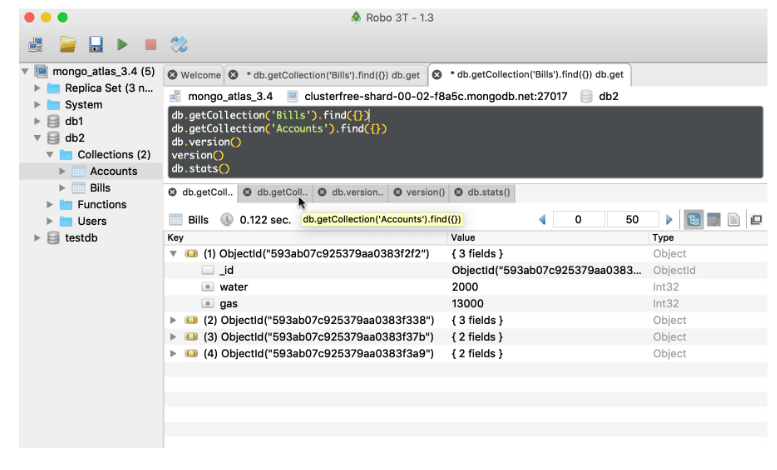
Check out this documentation to see how you can connect Robo 3T to your MongoDB DBaaS account.
6. Mongo Management Studio
Mongo Management Studio (MMS) is our last choice in this article. You may feel that the top three products have too many features that make things unnecessarily complex. Sometimes, all you need is a simple interface with only the core features. If so, this is the best tool for you. With MMS’s light and clean interface, you can get your work done straightforwardly.
In terms of pricing, it offers three different versions. Community edition was released in early 2018, which lacks some features compared to paid versions, such as import/export, SSH connections, user management, support, etc.. There are two types of paid versions offered; Professional (local) and Enterprise (webserver). Both have similar features, but the Enterprise edition gives you five license for less than three times the price of the Professional edition, which is ideal for small teams. MMS Professional starts at 25€/user.
This cross-platform system lets you enter your queries easily in many formats. Currently, you can work with MongoDB 3.0, 3.2 and 3.4 versions. Furthermore, MMS supports remote databases with SSH tunnels.
Here are some additional services offered by Mongo Management Studio:
- With the inline-edit feature, you can edit data on the fly.
- Simple, flexible and intuitional GUI.
- All MMS actions can be used against a replica set.
- Powerful aggregation framework.
- Thorough documentation on all MMS features.
Which MongoDB GUI is best?
Note that all these products are providing free and commercial versions. If you are an individual developer or a freelancer, we believe the free versions will be enough for you. But if you are anything more than a single developer such as two of you working on big projects, we highly recommend you to go for commercial versions. That will pay off well in the end. Also, most of these products offer a trial period for paid versions. You can use it to find out whether the product meets your expectations.
In the end, it all boils down to your requirements in terms of budget, usage needs, team members, the number of features, etc. Take your pick and good luck on your journey. Build something awesome and sign up for our newsletter below, we might just feature your project!
The Best Mongo GUI’s of 2016
1. MongoDB Compass
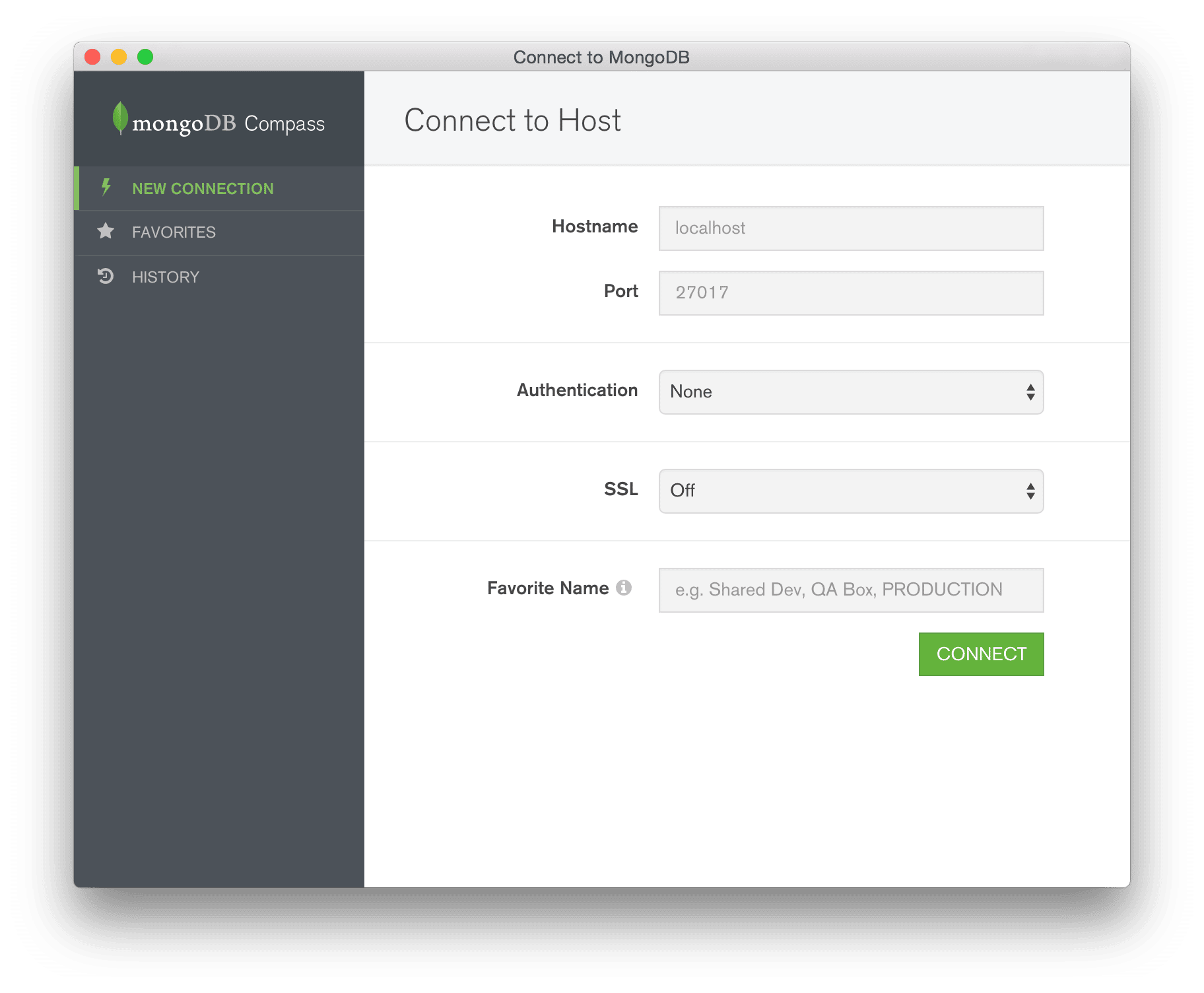
It provides users with a graphical view of their MongoDB schema without requiring the use of query language. In MongoDB, collections do not enforce a rigidly defined document structure. This can make it difficult to explore and understand the underlying data and its structure without a tool like MongoDB Compass.
MongoDB Compass analyses your documents and displays rich structures within your collections in a simple and intuitive GUI. It allows you to quickly visualize and explore your schema to understand the frequency, types, and ranges of fields in your dataset.
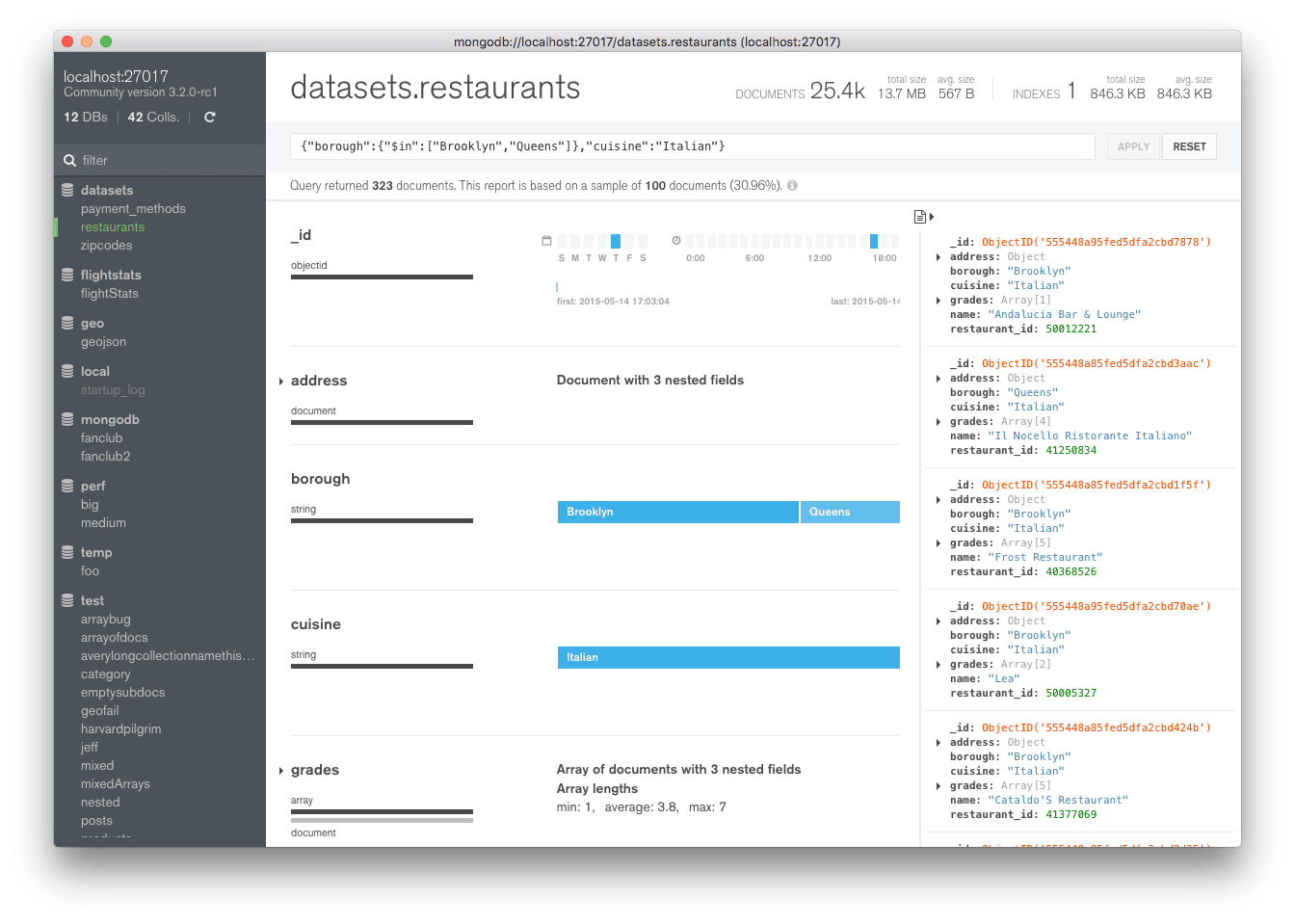
Here are some features provided by MongoDB Compass:
- Visually explore your data
- Run ad hoc queries in seconds
- View your query performance
- Compass empowers you to make smarter decisions about indexing, document validation, and more
- No command line needed
Note: While the UI looks slick, it is neither a full-featured development UI or a full-featured BI tool to mine your data. Will be interesting to see in which direction it will proceed.
Platforms: Mac OS X, Windows
Pricing: Free for development purposes; contact MongoDB for Commercial/Advanced Licenses
2. Robomongo
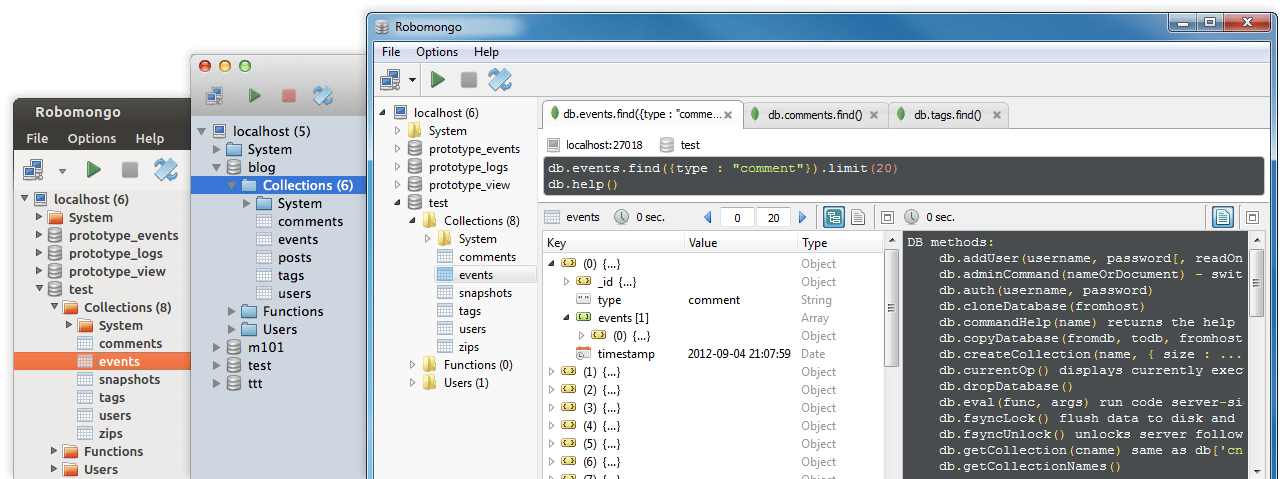
Robomongo: Cross Platform Availability Robomongo remains a top contender on our list of the best MongoDB GUIs. Robomongo embeds the same engine and environment that is a part of MongoDB shell (3.2) and also provides a neat autocomplete feature with a full library of commands. It also analyses and executes it in an internal JavaScript VM, allowing us to give you a run-time auto-completion, impossible to obtain statically.

Here are some features provided by Robomongo:
- Native and cross-platform MongoDB manager
- Uses very little of your machine resources
- The first and still the only tool that embeds real MongoDB shell
- The first graphical tool that provides real auto-completion
Note: Full featured commercial grade development UI for MongoDB. Development was stopped for a long time due to funding issue but it appears to be back on track now. Platforms: Mac OS X, Windows, Linux Pricing: Free Community Edition, other versions start at $12/month billed annually.
More Info: https://robomongo.org/
3. Studio 3T
Studio 3T is another preferred tool for developers to work with MongoDB. Whether you’re exploring your local database or working with shards and replica sets, Studio 3T allows you to do all of it. Studio 3T helps thousands of MongoDB developers and administrators with their everyday jobs by providing the finest MongoDB tools in the market.
The Studio 3T Shell provides effortless multi-line editing and auto-completion – including of course database and collection names. Creating complex update or aggregation queries is a breeze. Studio 3T Shell output is fully formatted, highlighted and searchable. A complete command history is also available.
Here are some more features provided by Studio 3T:
- Free to use forever for non-commercial use
- Uniquely, built and optimized specifically for MongoDB
- Full MongoDB shell integration with IntelliShell
Note: Full featured Development UI – Highly recommended for any developer working with MongoDB Platforms: Windows, Mac, Linux
Pricing: Free for non-commercial use, other versions start at $299 one-time-only fees.
More info here.
4. MongoBooster
MongoBooster is a shell-centric cross-platform GUI tool for MongoDB v2.2-3.2, which provides update-in-place, fluent query builder, ES6 syntax support and true Intellisense experience.
The built-in language service knows all possible completions, methods, properties, variables, keywords, even the MongoDB collection names, field names, and operators. The IntelliSense suggestions will pop up as you type.
MongoBooster supports mongoose-like fluent query builder API which enables you to build up a query using chaining syntax, rather than specifying a JSON object. The aggregation framework is now fluent as well. You can use it as currently documented or via the chainable methods.
Here are some more features provided:
- Tons of built-in snippets
- MongoDB shell extensions to make life inside of the MongoDB shell a little bit easier
- MongoBooster supports in-place editing in result tree view
Full list of features: http://mongobooster.com/features
Platforms: Mac OS X, Windows, Linux Pricing: Free for non-commercial use, other versions start at $79.
More info here.
The Best Mongo GUI’s of 2014
1. MongoVue
MongoVue is a desktop GUI for the windows platform. It has a simple clean UI and the basic features are free. Data can be presented in text view, tree view or table view. You can also save your find queries for later usage – we find this rather convenient. The more advanced features require you to purchase a license. Overall the software appears stable and well maintained.
2. MongoHub
is a native Mac GUI for MongoDB. It provides you an option to connect to your MongoDB server through an SSH tunnel which is fairly convenient from a security perspective. The “StatMonitor” feature gives you a live display of stats a.k.a mongostat. The query interface is a little bit more limited in that it only seems to support a tree view. Also, there is no way to save a find query for later. In our experience, the software appears to work fairly well but it doesn’t seem like it is being maintained – so use at your own risk.
3. RockMongo
An HTML-based MongoDB GUI. The GUI is authored in PHP and is open source. The downside of the HTML based approach is that you need a PHP server to run this GUI. You can also choose to run the PHP server on your local box. The UI is no frill, fairly easy to use and supports all the common options of working with collections, stats etc. The find interface only presents data in a tabular/text model – so it could be an issue when you are working with multilevel documents. Also, there doesn’t seem to be a lot of check-in activity – so we suspect the project is inactive.
4. RoboMongo
A shell-centric MongoDB GUI that supports the Windows, iOS, and Linux platforms. It’s still early days for RoboMongo with the latest version being 0.8.4. It is also one of the few GUI’s that supports SSL connections to your MongoDB server. There is also support for connecting through an SSH tunnel. The query interface displays data in tree view, table view and text view.
You can also save your queries for later usage. One of the coolest features is that it also has support for the shell – so you can still continue to use the shell commands that you are comfortable with. There are some quirks in the UI which I think will get worked out over time. If actively maintained I think this could be the best cross-platform GUI for MongoDB.
Further Reading:
– MongoDB vs Cassandra Comparison
– Why updating your MongoDB matters
– How to enable logging for Mongoose and the MongoDB Node.JS driver

